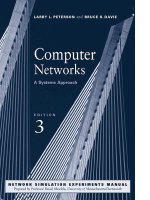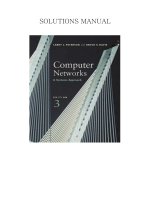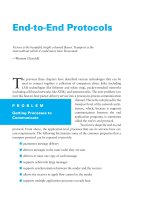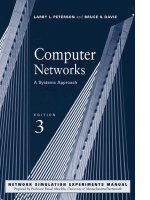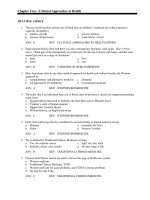Computer Networks A Systems Approach 3rd Edition
Bạn đang xem bản rút gọn của tài liệu. Xem và tải ngay bản đầy đủ của tài liệu tại đây (4.73 MB, 838 trang )
THIRD EDITION
COMPUTER
NETWORKS
A Systems Approach
The Morgan Kaufmann Series in Networking
Series Editor, David Clark, M.I.T.
Computer Networks: A Systems Approach, 3e
Larry L. Peterson and Bruce S. Davie
Network Architecture, Analysis, and Design, 2e
James D. McCabe
MPLS Network Management: MIBs, Tools, and Techniques
Thomas D. Nadeau
Developing IP-Based Services: Solutions for Service Providers and Vendors
Monique Morrow and Kateel Vijayananda
Telecommunications Law in the Internet Age
Sharon K. Black
Optical Networks: A Practical Perspective, 2e
Rajiv Ramaswami and Kumar N. Sivarajan
Internet QoS: Architectures and Mechanisms
Zheng Wang
TCP/IP Sockets in Java: Practical Guide for Programmers
Michael J. Donahoo and Kenneth L. Calvert
TCP/IP Sockets in C: Practical Guide for Programmers
Kenneth L. Calvert and Michael J. Donahoo
Multicast Communication: Protocols, Programming, and Applications
Ralph Wittmann and Martina Zitterbart
MPLS: Technology and Applications
Bruce Davie and Yakov Rekhter
High-Performance Communication Networks, 2e
Jean Walrand and Pravin Varaiya
Internetworking Multimedia
Jon Crowcroft, Mark Handley, and Ian Wakeman
Understanding Networked Applications: A First Course
David G. Messerschmitt
Integrated Management of Networked Systems: Concepts, Architectures,
and their Operational Application
Heinz-Gerd Hegering, Sebastian Abeck, and Bernhard Neumair
Virtual Private Networks: Making the Right Connection
Dennis Fowler
Networked Applications: A Guide to the New Computing Infrastructure
David G. Messerschmitt
Modern Cable Television Technology: Video, Voice, and Data Communications
Walter Ciciora, James Farmer, and David Large
Switching in IP Networks: IP Switching, Tag Switching, and Related Technologies
Bruce S. Davie, Paul Doolan, and Yakov Rekhter
Wide Area Network Design: Concepts and Tools for Optimization
Robert S. Cahn
Frame Relay Applications: Business and Technology Case Studies
James P. Cavanagh
For further information on these books and for a list of forthcoming titles, please visit
our website at
THIRD EDITION
Larry L. Peterson & Bruce S. Davie
COMPUTER
NETWORKS
A Systems Approach
Senior Editor Rick Adams
Publishing Services Manager Simon Crump
Developmental Editor Karyn Johnson
Cover Design Ross Carron Design
Cover Image Vasco de Gama Bridge, Lisbon, Portugal
Composition/Illustration International Typesetting and Composition
Copyeditor Ken DellaPenta
Proofreader Jennifer McClain
Indexer Steve Rath
Printer Courier Corporation
Designations used by companies to distinguish their products are often claimed as trademarks
or registered trademarks. In all instances in which Morgan Kaufmann Publishers is aware of a
claim, the product names appear in initial capital or all capital letters. Readers, however, should
contact the appropriate companies for more complete information regarding trademarks and
registration.
Morgan Kaufmann Publishers
An Imprint of Elsevier Science
340 Pine Street, Sixth Floor
San Francisco, CA 94104-3205
www.mkp.com
© 2003 by Elsevier Science (USA)
All rights reserved
Printed in the United States of America
07 06 05 04 03
5 4 3 2 1
No part of this publication may be reproduced, stored in a retrieval system, or transmitted in
any form or by any means—electronic, mechanical, photocopying, or otherwise—without the
prior written permission of the publisher.
Library of Congress Control Number: xxxxxxxxxx
ISBN: 1-55860-832-X (Casebound)
ISBN: 1-55860-833-8 (Paperback)
This book is printed on acid-free paper.
To Lee Peterson and Robert Davie
This Page Intentionally Left Blank
F O R E W O R D
David Clark
Massachusetts Institute of Technology
T
his third edition represents another major upgrade to this classic networking
book. The field continues to change fast, and new concepts emerge with amazing speed. This version expands its discussion of a lot of important new topics, including peer-to-peer networks, Ipv6, overlay and content distribution networks,
MPLS and switching, wireless and mobile technology, and more. It also contains an
earlier and stronger focus on applications, which reflects the student and professional’s
increased familiarity with a wide range of networked applications. The book continues
its tradition of giving you the facts you need to understand today’s world.
But it has not lost track of its larger goal, to tell you not only the facts but the
why behind the facts. The philosophy of the book remains the same: to be timely but
timeless. What this book will teach you in today’s networked world will give you the
insight needed to work in tomorrow’s landscape. And that is important, since there
is no reason to believe that the evolution of networks is going to slow down anytime
soon.
It is hard to remember what the world looked like only ten years ago. Back then
the Internet was not really a commercial reality. Ten megabits per second was really
fast. We didn’t worry about spam and virus attacks—we left our computers unguarded
and hardly worried. Those times were simpler, but today may be more exciting. And
you better believe that tomorrow will be different from today: at least as exciting, with
luck no less trustworthy, and certainly bigger, faster and filled with fresh innovation.
So I hope Larry and Bruce can relax for a little before they have to start the next
revision. Meanwhile, use this book to learn about today and get ready for tomorrow.
Have fun.
This Page Intentionally Left Blank
F O R E W O R D
T O
T H E
F I R S T
E D I T I O N
David Clark
Massachusetts Institute of Technology
T
he term spaghetti code is universally understood as an insult. All good computer
scientists worship the god of modularity, since modularity brings many benefits,
including the all-powerful benefit of not having to understand all parts of a
problem at the same time in order to solve it. Modularity thus plays a role in presenting
ideas in a book, as well as in writing code. If a book’s material is organized effectively—
modularly—the reader can start at the beginning and actually make it to the end.
The field of network protocols is perhaps unique in that the “proper” modularity
has been handed down to us in the form of an international standard: the seven-layer
reference model of network protocols from the ISO. This model, which reflects a
layered approach to modularity, is almost universally used as a starting point for
discussions of protocol organization, whether the design in question conforms to the
model or deviates from it.
It seems obvious to organize a networking book around this layered model.
However, there is a peril to doing so, because the OSI model is not really successful
at organizing the core concepts of networking. Such basic requirements as reliability,
flow control, or security can be addressed at most, if not all, of the OSI layers. This
fact has led to great confusion in trying to understand the reference model. At times it
even requires a suspension of disbelief. Indeed, a book organized strictly according to
a layered model has some of the attributes of spaghetti code.
Which brings us to this book. Peterson and Davie follow the traditional layered
model, but they do not pretend that this model actually helps in the understanding of
the big issues in networking. Instead, the authors organize discussion of fundamental
concepts in a way that is independent of layering. Thus, after reading the book, readers
will understand flow control, congestion control, reliability enhancement, data representation, and synchronization, and will separately understand the implications of
addressing these issues in one or another of the traditional layers.
This is a timely book. It looks at the important protocols in use today—especially
the Internet protocols. Peterson and Davie have a long involvement in and much
experience with the Internet. Thus their book reflects not just the theoretical issues in
x
Foreword to the First Edition
protocol design, but the real factors that matter in practice. The book looks at some of
the protocols that are just emerging now, so the reader can be assured of an up-to-date
perspective. But most importantly, the discussion of basic issues is presented in a way
that derives from the fundamental nature of the problem, not the constraints of the
layered reference model or the details of today’s protocols. In this regard, what this
book presents is both timely and timeless. The combination of real-world relevance,
current examples, and careful explanation of fundamentals makes this book unique.
C O N T E N T S
Foreword
Foreword to the First Edition
Preface
vii
ix
xix
1 Foundation
Problem: Building a Network
2
1.1
Applications
4
1.2
Requirements
6
1.2.1 Connectivity
1.3
1.4
1.5
1.6
7
1.2.2 Cost-Effective Resource Sharing
10
1.2.3 Support for Common Services
15
Network Architecture
19
1.3.1 Layering and Protocols
20
1.3.2 OSI Architecture
26
1.3.3 Internet Architecture
27
Implementing Network Software
30
1.4.1 Application Programming Interface (Sockets)
31
1.4.2 Example Application
33
1.4.3 Protocol Implementation Issues
36
Performance
40
1.5.1 Bandwidth and Latency
40
1.5.2 Delay × Bandwidth Product
44
1.5.3 High-Speed Networks
46
1.5.4 Application Performance Needs
48
Summary
50
Open Issue: Ubiquitous Networking
51
Further Reading
52
Exercises
55
xii
Contents
2 Direct Link Networks
Problem: Physically Connecting Hosts
2.1
2.2
2.3
2.4
2.5
Hardware Building Blocks
66
2.1.1 Nodes
66
2.1.2 Links
67
Encoding (NRZ, NRZI, Manchester, 4B/5B)
75
Framing
79
2.3.1 Byte-Oriented Protocols (BISYNC, PPP, DDCMP)
80
2.3.2 Bit-Oriented Protocols (HDLC)
83
2.3.3 Clock-Based Framing (SONET)
84
Error Detection
88
2.4.1 Two-Dimensional Parity
89
2.4.2 Internet Checksum Algorithm
90
2.4.3 Cyclic Redundancy Check
92
Reliable Transmission
97
2.5.1 Stop-and-Wait
2.5.2 Sliding Window
2.6
2.7
2.8
2.9
64
98
101
2.5.3 Concurrent Logical Channels
110
Ethernet (802.3)
111
2.6.1 Physical Properties
112
2.6.2 Access Protocol
114
2.6.3 Experience with Ethernet
119
Token Rings (802.5, FDDI)
120
2.7.1 Physical Properties
121
2.7.2 Token Ring Media Access Control
122
2.7.3 Token Ring Maintenance
125
2.7.4 Frame Format
126
2.7.5 FDDI
127
Wireless (802.11)
131
2.8.1 Physical Properties
132
2.8.2 Collision Avoidance
133
2.8.3 Distribution System
134
2.8.4 Frame Format
136
Network Adaptors
137
2.9.1 Components
138
2.9.2 View from the Host
139
2.9.3 Memory Bottleneck
144
2.10 Summary
146
Contents
xiii
Open Issue: Does It Belong in Hardware?
147
Further Reading
148
Exercises
150
3 Packet Switching
Problem: Not All Networks Are Directly Connected
3.1
3.2
3.3
3.4
3.5
164
Switching and Forwarding
166
3.1.1 Datagrams
168
3.1.2 Virtual Circuit Switching
170
3.1.3 Source Routing
177
Bridges and LAN Switches
180
3.2.1 Learning Bridges
181
3.2.2 Spanning Tree Algorithm
185
3.2.3 Broadcast and Multicast
189
3.2.4 Limitations of Bridges
190
Cell Switching (ATM)
192
3.3.1 Cells
193
3.3.2 Segmentation and Reassembly
198
3.3.3 Virtual Paths
203
3.3.4 Physical Layers for ATM
204
3.3.5 ATM in the LAN
205
Implementation and Performance
210
3.4.1 Ports
212
3.4.2 Fabrics
216
Summary
220
Open Issue: The Future of ATM
221
Further Reading
221
Exercises
223
4 Internetworking
Problem: There Is More Than One Network
4.1
234
Simple Internetworking (IP)
236
4.1.1 What Is an Internetwork?
236
4.1.2 Service Model
238
4.1.3 Global Addresses
250
4.1.4 Datagram Forwarding in IP
252
4.1.5 Address Translation (ARP)
258
4.1.6 Host Configuration (DHCP)
263
xiv
4.2
4.3
4.4
4.5
4.6
Contents
4.1.7 Error Reporting (ICMP)
266
4.1.8 Virtual Networks and Tunnels
267
Routing
271
4.2.1 Network as a Graph
272
4.2.2 Distance Vector (RIP)
274
4.2.3 Link State (OSPF)
282
4.2.4 Metrics
291
4.2.5 Routing for Mobile Hosts
295
Global Internet
299
4.3.1 Subnetting
301
4.3.2 Classless Routing (CIDR)
306
4.3.3 Interdomain Routing (BGP)
308
4.3.4 Routing Areas
316
4.3.5 IP Version 6 (IPv6)
318
Multicast
331
4.4.1 Link-State Multicast
332
4.4.2 Distance-Vector Multicast
332
4.4.3 Protocol Independent Multicast (PIM)
336
Multiprotocol Label Switching (MPLS)
340
4.5.1 Destination-Based Forwarding
340
4.5.2 Explicit Routing
346
4.5.3 Virtual Private Networks and Tunnels
348
Summary
352
Open Issue: Deployment of IPV6
353
Further Reading
354
Exercises
355
5 End-to-End Protocols
Problem: Getting Processess to Communicate
5.1
5.2
374
Simple Demultiplexer (UDP)
376
Reliable Byte Stream (TCP)
378
5.2.1 End-to-End Issues
379
5.2.2 Segment Format
382
5.2.3 Connection Establishment and Termination
384
5.2.4 Sliding Window Revisited
389
5.2.5 Triggering Transmission
395
5.2.6 Adaptive Retransmission
397
5.2.7 Record Boundaries
401
Contents
5.3
xv
5.2.8 TCP Extensions
402
5.2.9 Alternative Design Choices
403
Remote Procedure Call
405
5.3.1 Bulk Transfer (BLAST)
408
5.3.2 Request/Reply (CHAN)
414
5.3.3 Dispatcher (SELECT)
423
5.3.4 Putting It All Together (SunRPC, DCE)
424
5.4
Performance
431
5.5
Summary
434
Open Issue: Application-Specific Protocols
435
Further Reading
436
Exercises
437
6 Congestion Control and Resource Allocation
Problem: Allocating Resources
6.1
6.2
6.3
6.4
6.5
6.6
450
Issues in Resource Allocation
452
6.1.1 Network Model
452
6.1.2 Taxonomy
456
6.1.3 Evaluation Criteria
458
Queuing Disciplines
461
6.2.1 FIFO
462
6.2.2 Fair Queuing
463
TCP Congestion Control
468
6.3.1 Additive Increase/Multiplicative Decrease
468
6.3.2 Slow Start
471
6.3.3 Fast Retransmit and Fast Recovery
476
Congestion-Avoidance Mechanisms
478
6.4.1 DECbit
478
6.4.2 Random Early Detection (RED)
480
6.4.3 Source-Based Congestion Avoidance
486
Quality of Service
492
6.5.1 Application Requirements
493
6.5.2 Integrated Services (RSVP)
499
6.5.3 Differentiated Services (EF, AF)
509
6.5.4 ATM Quality of Service
513
6.5.5 Equation-Based Congestion Control
517
Summary
518
xvi
Contents
Open Issue: Inside versus Outside the Network
519
Further Reading
520
Exercises
521
7 End-to-End Data
Problem: What Do We Do with the Data?
7.1
7.2
7.3
534
Presentation Formatting
536
7.1.1 Taxonomy
537
7.1.2 Examples (XDR, ASN.1, NDR)
541
7.1.3 Markup Languages (XML)
545
Data Compression
548
7.2.1 Lossless Compression Algorithms
550
7.2.2 Image Compression (JPEG)
552
7.2.3 Video Compression (MPEG)
557
7.2.4 Transmitting MPEG over a Network
562
7.2.5 Audio Compression (MP3)
566
Summary
568
Open Issue: Computer Networks Meet Consumer Electronics
568
Further Reading
569
Exercises
570
8 Network Security
Problem: Securing the Data
8.1
8.2
8.3
578
Cryptographic Algorithms
580
8.1.1 Requirements
582
8.1.2 Secret Key Encryption (DES)
583
8.1.3 Public Key Encryption (RSA)
588
8.1.4 Message Digest Algorithms (MD5)
591
8.1.5 Implementation and Performance
593
Security Mechanisms
594
8.2.1 Authentication Protocols
594
8.2.2 Message Integrity Protocols
598
8.2.3 Public Key Distribution (X.509)
601
Example Systems
604
8.3.1 Pretty Good Privacy (PGP)
605
8.3.2 Secure Shell (SSH)
607
8.3.3 Transport Layer Security (TLS, SSL, HTTPS)
610
8.3.4 IP Security (IPSEC)
614
Contents
8.4
8.5
xvii
Firewalls
617
8.4.1 Filter-Based Firewalls
618
8.4.2 Proxy-Based Firewalls
620
8.4.3 Limitations
622
Summary
622
Open Issue: Denial-of-Service Attacks
623
Further Reading
624
Exercises
625
9 Applications
Problem: Applications Need Their Own Protocols
9.1
9.2
9.3
9.4
9.5
632
Name Service (DNS)
634
9.1.1 Domain Hierarchy
635
9.1.2 Name Servers
636
9.1.3 Name Resolution
640
Traditional Applications
643
9.2.1 Electronic Mail (SMTP, MIME, IMAP)
644
9.2.2 World Wide Web (HTTP)
650
9.2.3 Network Management (SNMP)
657
Multimedia Applications
660
9.3.1 Real-time Transport Protocol (RTP)
660
9.3.2 Session Control and Call Control (SDP, SIP, H.323)
671
Overlay Networks
680
9.4.1 Routing Overlays
682
9.4.2 Peer-to-Peer Networks
690
9.4.3 Content Distribution Networks
698
Summary
704
Open Issue: New Network Artichitecture
704
Further Reading
705
Exercises
707
Glossary
715
Bibliography
743
Solutions to Selected Exercises
763
Index
777
About the Authors
810
This Page Intentionally Left Blank
P R E F A C E
W
hen the first edition of this book was published in 1996, it was a novelty to
be able to order merchandise on the Internet, and a company that advertised
its domain name was considered cutting edge. Today, Internet commerce is
a fact of life, and “.com” stocks have gone through an entire boom and bust cycle.
A host of new technologies ranging from optical switches to wireless networks are
now becoming mainstream. It seems the only predictable thing about the Internet is
constant change.
Despite these changes the question we asked in the first edition is just as valid
today: What are the underlying concepts and technologies that make the Internet
work? The answer is that much of the TCP/IP architecture continues to function just
as was envisioned by its creators nearly 30 years ago. This isn’t to say that the Internet
architecture is uninteresting, quite the contrary. Understanding the design principles
that underlie an architecture that has not only survived but fostered the kind of growth
and change that the Internet has seen over the past three decades is precisely the right
place to start. Like the previous editions, the third edition makes the “why” of the
Internet architecture its cornerstone.
Audience
Our intent is that the book should serve as the text for a comprehensive networking
class, at either the graduate or upper-division undergraduate level. We also believe that
the book’s focus on core concepts should be appealing to industry professionals who
are retraining for network-related assignments, as well as current network practitioners
who want to understand the “whys” behind the protocols they work with every day
and to see the big picture of networking.
It is our experience that both students and professionals learning about networks
for the first time often have the impression that network protocols are some sort of edict
handed down from on high, and that their job is to learn as many TLAs (three-letter
acronyms) as possible. In fact, protocols are the building blocks of a complex system
developed through the application of engineering design principles. Moreover, they
are constantly being refined, extended, and replaced based on real-world experience.
xx
Preface
With this in mind, our goal with this book is to do more than survey the protocols
in use today. Instead, we explain the underlying principles of sound network design.
We feel that this grasp of underlying principles is the best tool for handling the rate of
change in the networking field.
Changes in the Third Edition
Even though our focus is on the underlying principles of networking, we illustrate
these principles using examples from today’s working Internet. Therefore, we added a
significant amount of new material to track many of the important recent advances in
networking. We also deleted, reorganized, and changed the focus of existing material
to reflect changes that have taken place over the past seven years.
Perhaps the most significant change we have noticed since writing the first edition
is that almost every reader now has some familiarity with networked applications such
as the World Wide Web and email. For this reason, we have increased the focus on
applications, starting in the first chapter. We use applications as the motivation for
the study of networking, and to derive a set of requirements that a useful network
must meet if it is to support both current and future applications on a global scale.
However, we retain the problem-solving approach of previous editions that starts with
the problem of interconnecting hosts and works its way up the layers to conclude with
a detailed examination of application-layer issues. We believe it is important to make
the topics covered in the book relevant by starting with applications and their needs. At
the same time, we feel that higher-layer issues, such as application-layer and transportlayer protocols, are best understood after the basic problems of connecting hosts and
switching packets have been explained.
Another important change in this edition is in the exercises. We have increased
the number and quality of exercises; we have attempted to identify those that are
especially difficult or that require above-average levels of mathematical knowledge
(these are marked with an icon ); and in each chapter we have added a number of
exercises with worked solutions that are included in the book. As before, the complete
set of exercise solutions is available only to instructors.
As we did in the second edition, we have added or increased coverage of important new topics and brought other topics up-to-date. Major new or substantially
updated topics in this edition are
■ a new section on Multiprotocol Label Switching (MPLS), including coverage
of traffic engineering and virtual private networks
■ a new section on overlay networks, including “peer-to-peer” networking and
“content distribution networks”
Preface
xxi
■ greatly expanded coverage on protocols for multimedia applications, such as
Session Initiation Protocol (SIP) and Session Description Protocol (SDP)
■ updated coverage of congestion-control mechanisms, including selective acknowledgments for TCP, equation-based congestion control, and explicit congestion notification
■ updated security coverage, including distributed denial of service (DDoS) attacks
■ updated material on wireless technology, including spread spectrum techniques and the emerging 802.11 standards
Finally, the book is now supplemented by a comprehensive set of laboratory exercises designed to illustrate the key concepts through simulation experiments. Sections
that discuss material covered by the laboratory exercises are marked with the icon
shown in the margin. Details on this new feature of the book appear below.
Approach
For an area that’s as dynamic and changing as computer networks, the most important
thing a textbook can offer is perspective—to distinguish between what’s important and
what’s not, and between what’s lasting and what’s superficial. Based on our experience over the past 20 years doing research that has led to new networking technology,
teaching undergraduate and graduate students about the latest trends in networking, and delivering advanced networking products to market, we have developed a
perspective—which we call the systems approach—that forms the soul of this book.
The systems approach has several implications:
■ Rather than accept existing artifacts as gospel, we start with first principles
and walk you through the thought process that led to today’s networks. This
allows us to explain why networks look like they do. It is our experience that
once you understand the underlying concepts, any new protocol that you are
confronted with will be relatively easy to digest.
■ Although the material is loosely organized around the traditional network
layers, starting at the bottom and moving up the protocol stack, we do not
adopt a rigid layered approach. Many topics—congestion control and security
are good examples—have implications up and down the hierarchy, and so
we discuss them outside the traditional layered model. In short, we believe
layering makes a good servant but a poor master; it’s more often useful to
take an end-to-end perspective.
xxii
Preface
■ Rather than explain how protocols work in the abstract, we use the most
important protocols in use today—many of them from the TCP/IP Internet—
to illustrate how networks work in practice. This allows us to include realworld experiences in the discussion.
■ Although at the lowest levels networks are constructed from commodity hardware that can be bought from computer vendors and communication services
that can be leased from the phone company, it is the software that allows networks to provide new services and adapt quickly to changing circumstances.
It is for this reason that we emphasize how network software is implemented,
rather than stopping with a description of the abstract algorithms involved.
We also include code segments taken from a working protocol stack to illustrate how you might implement certain protocols and algorithms.
■ Networks are constructed from many building-block pieces, and while it is
necessary to be able to abstract away uninteresting elements when solving
a particular problem, it is essential to understand how all the pieces fit together to form a functioning network. We therefore spend considerable time
explaining the overall end-to-end behavior of networks, not just the individual components, so that it is possible to understand how a complete network
operates, all the way from the application to the hardware.
■ The systems approach implies doing experimental performance studies, and
then using the data you gather both to quantitatively analyze various design
options and to guide you in optimizing the implementation. This emphasis on
empirical analysis pervades the book.
■ Networks are like other computer systems—for example, operating systems,
processor architectures, distributed and parallel systems, and so on. They
are all large and complex. To help manage this complexity, system builders
often draw on a collection of design principles. We highlight these design
principles as they are introduced throughout the book, illustrated, of course,
with examples from computer networks.
Pedagogy and Features
The third edition retains several features that we encourage you to take advantage of:
■ Problem statements. At the start of each chapter, we describe a problem that
identifies the next set of issues that must be addressed in the design of a
network. This statement introduces and motivates the issues to be explored
in the chapter.
Preface
xxiii
■ Shaded sidebars. Throughout the text, shaded sidebars elaborate on the topic
being discussed or introduce a related advanced topic. In many cases, these
sidebars relate real-world anecdotes about networking.
■ Highlighted paragraphs. These paragraphs summarize an important nugget
of information that we want you to take away from the discussion, such as a
widely applicable system design principle.
■ Real protocols. Even though the book’s focus is on core concepts rather than
existing protocol specifications, real protocols are used to illustrate most of the
important ideas. As a result, the book can be used as a source of reference for
many protocols. To help you find the descriptions of the protocols, each applicable section heading parenthetically identifies the protocols described in that
section. For example, Section 5.2, which describes the principles of reliable
end-to-end protocols, provides a detailed description of TCP, the canonical
example of such a protocol.
■ Open issues. We conclude the main body of each chapter with an important
issue that is currently being debated in the research community, the commercial world, or society as a whole. We have found that discussing these issues
helps to make the subject of networking more relevant and exciting.
■ Further reading. These highly selective lists appear at the end of each chapter.
Each list generally contains the seminal papers on the topics just discussed.
We strongly recommend that advanced readers (e.g., graduate students) study
the papers in this reading list to supplement the material covered in the
chapter.
Road Map and Course Use
The book is organized as follows:
■ Chapter 1 introduces the set of core ideas that are used throughout the rest
of the text. Motivated by widespread applications, it discusses what goes into
network architecture, and it defines the quantitative performance metrics that
often drive network design.
■ Chapter 2 surveys a wide range of low-level network technologies, ranging
from Ethernet to token ring to wireless. It also describes many of the issues
that all data link protocols must address, including encoding, framing, and
error detection.
xxiv
Preface
■ Chapter 3 introduces the basic models of switched networks (datagrams versus
virtual circuits) and describes one prevalent switching technology (ATM) in
some detail. It also discusses the design of hardware-based switches.
■ Chapter 4 introduces internetworking and describes the key elements of the
Internet Protocol (IP). A central question addressed in this chapter is how
networks that scale to the size of the Internet are able to route packets.
■ Chapter 5 moves up to the transport level, describing both the Internet’s Transmission Control Protocol (TCP) and Remote Procedure Call (RPC) used to
build client/server applications in detail.
■ Chapter 6 discusses congestion control and resource allocation. The issues
in this chapter cut across both the network level (Chapters 3 and 4) and the
transport level (Chapter 5). Of particular note, this chapter describes how
congestion control works in TCP, and it introduces the mechanisms used by
both the Internet and ATM to provide quality of service.
■ Chapter 7 considers the data sent through a network. This includes the problems of both presentation formatting and data compression. The discussion
of compression includes explanations of how MPEG video compression and
MP3 audio compression work.
■ Chapter 8 discusses network security, ranging from an overview of cryptography protocols (DES, RSA, MD5), to protocols for security services (authentication, digital signature, message integrity), to complete security systems
(privacy enhanced email, IPSEC). The chapter also discusses pragmatic issues
like firewalls.
■ Chapter 9 describes a representative sample of network applications and the
protocols they use, including traditional applications like email and the Web,
multimedia applications such as IP telephony and video streaming, and overlay
networks like peer-to-peer file sharing and content distribution networks.
For an undergraduate course, extra class time will most likely be needed to help
students digest the introductory material in the first chapter, probably at the expense
of the more advanced topics covered in Chapters 6 through 8. Chapter 9 then returns
to the popular topic of network applications. In contrast, the instructor for a graduate
course should be able to cover the first chapter in only a lecture or two—with students
studying the material more carefully on their own—thereby freeing up additional
class time to cover the last four chapters in depth. Both graduate and undergraduate
classes will want to cover the core material contained in the middle four chapters

